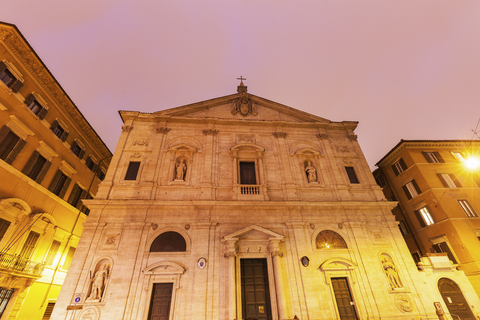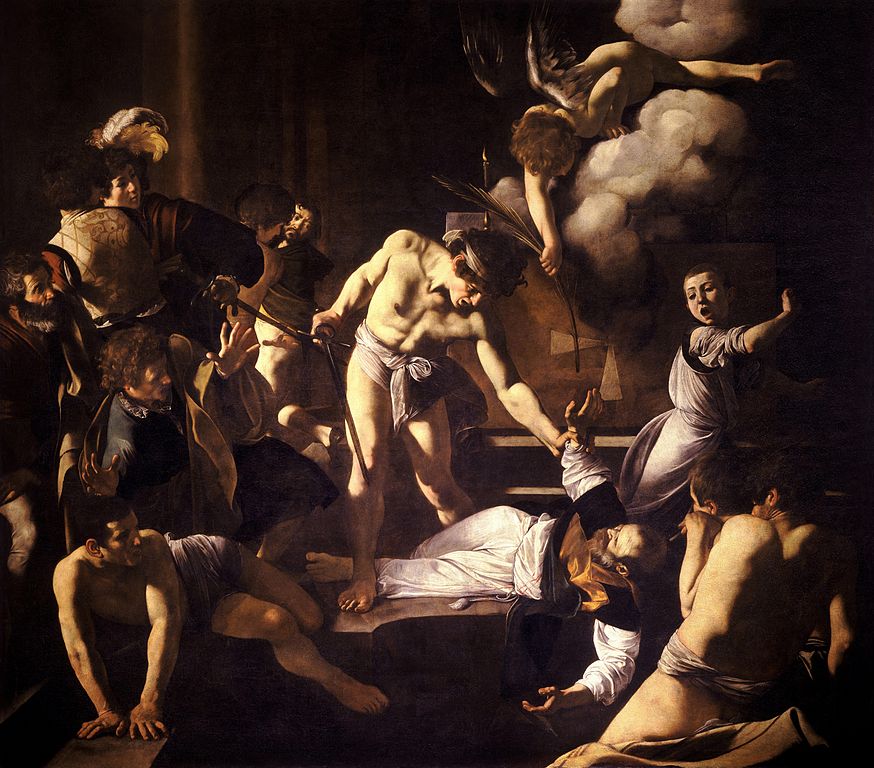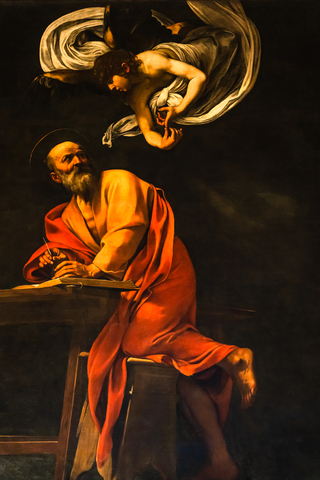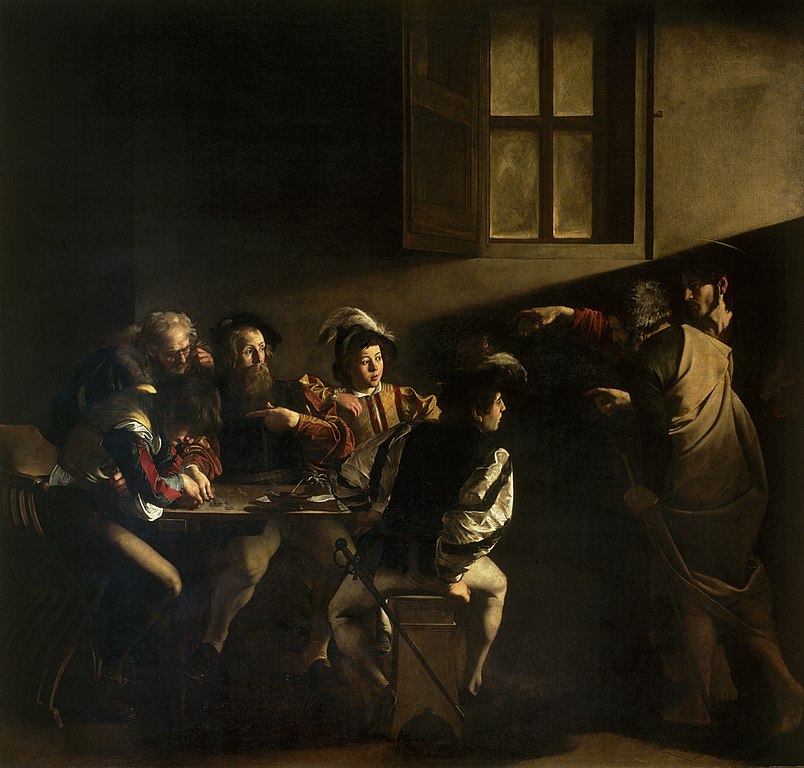
By Staff Middle Land, Staff middle land
By Cedric Rischitelli
Planning a visit to Rome can be challenging. There is something to see at each turn; no street lacks history, and even forgotten little churches can hide masterpieces inside their walls. Knowing this, it is normal to feel lost while planning a visit to the Italian capital. Therefore, it can be helpful to focus on a single artist while visiting Rome. Among the artists who lived in Rome, Caravaggio was one of the most prominent. The master of chiaroscuro made Rome his home for most of his artistic life. This series of articles will help you map an itinerary of Rome following the churches and museums that host Caravaggio’s artworks.
We start with the Church of St. Louis of the French. This Baroque-style Roman Catholic Church is located near Piazza Navona and was completed in 1589 by architects Giacomo della Porta (designer) and Domenico Fontana (builder). In 1518, Cardinal Giulio di Giuliano de Medici (later Pope Clement VII) commissioned the Church for the French community in Rome. On the façade, we see Pierre Lestache’s statues of Charlemagne, St. Louis, St. Clothilde, and St. Jeanne of Valois welcoming all visitors to the Church and celebrating French national history. Artists Domenichino, Plautilla Bricci, Guido Reni, and Cavalier d’Arpino decorated the interior with frescos and paintings, while Charles-Joseph Natoire painted the ceiling.

Once you enter the Church, you will find the Contarelli Chapel. Here, there are three stunning canvases that Caravaggio completed between 1599 and 1602: The Martyrdom of Saint Matthew (on the right), The Inspiration of Saint Matthew (in the center, above the altar) and The Calling of St Matthew (on the left). With these three works, Caravaggio juxtaposes the dark interior of a Roman church and the lighting of the chapel to create a decorative cycle that catches the viewer’s attention in a masterful contrast of light and darkness.
The Martyrdom of Saint Matthew is a violent scene. The canvas shows the moment a soldier, sent by the wicked king of Ethiopia, kills Saint Matthew the Evangelist. The scene occurs inside a church and resembles a theatre play, capturing the viewer’s attention. The central figure is the half-naked soldier. Armed with the sword that just killed Saint Matthew, the executor is the most illuminated character of the scene as if chosen as the central character. Saint Matthew lies on the floor, his arms open. He is dying with blood on his clothes, but no fear is on his face. Around them, worshippers react with horror, and some try to flee the scene. Within the crowd, Caravaggio paints himself as a figure in the background on the left-center side of the canvas. From above, an angel hands Matthew the palm of martyrdom. The divine creature is elegant, composed, and refined. The angel above creates a contrast to the chaos below. The presence of the angel indicates that this is not a tragic slaughter but a victory of sainthood over evil.
The Inspiration of Saint Matthew shows only two subjects:

Saint Matthew and an angel. The angel flies in the aerial sphere. He is sublime, perfect, and enveloped in rippled white sheets. From above, he comes to dictate the Gospel to Saint Matthew, and from below, Saint Matthew runs to his desk to write it. The man is old and wise. With a serious face, he looks at and listens to the divine messenger. Still, Caravaggio depicts a human Matthew: the saint’s posture is not composed like canonized saints in earlier paintings. For instance, we can see the saint’s bare feet. The light comes from above and illuminates only the two subjects and the desk while the background is completely dark. In this painting, we witness humankind, represented by Saint Matthew, collaborating with God, represented by the angel.
Finally, The Calling of Saint Matthew depicts a scene from the Gospel of Matthew 9:9: “Jesus saw a man named Matthew at his seat in the custom house, and said to him, ‘Follow me,’ and Matthew rose and followed Him.” However, Caravaggio masterfully adds drama and humanity to the scene with his painting. On the right, Jesus and Saint Peter enter the room of what could very well be a tavern. Jesus points at (the not-yet saint) Matthew, a tax collector. Matthew (the bearded man) sits on the left of the canvas alongside other tax collectors who do not even notice Jesus. Jesus and Saint Peter dress in modest robes while Matthew and the others dress as Caravaggio’s contemporary would dress. This detail adds a careful touch of modernity to the story and makes the scene more relatable to any viewer from the late 16th and early 17th centuries. On the upper part of the canvas, a beam of light enters the room, dramatically illuminating the people on the scene. This light is nothing less than a divine glow that depicts a moment of spiritual awakening. However, unlike the story in the scripture, Matthew does not immediately get up to follow Jesus. In Caravaggio’s depiction, Matthew has a very human moment of hesitation. He remains seated, looking stunned, and points at himself as if to ask, “Are you talking to me?”

Caravaggio drew clear inspirations from his predecessors while painting the subjects of this cycle; Michelangelo, Raphael, and Titan are some clear influences. However, as we can see in the Church of Saint Louis of the French, Caravaggio stands apart for two reasons. First, his painted subjects are relatable. They show human traits such as fear, bad posture, and doubt; and their expressions are vivid and realistic. Second, his use of chiaroscuro gives his art a sense of life and high drama. This humanity and unique use of light enhances an almost intimate emotional intensity to Caravaggio’s paintings. Caravaggio achieved this as he worked with live models and painted them as they were (showing flaws and defects) rather than following the canonized rule set by the Church. Those three paintings are significant in the story of Caravaggio, as they composed the first major public commission he received. The three canvases were successful and cemented Caravaggio’s reputation as a master artist. Therefore, they make for a perfect first stop on this tour.
The Church is open Monday to Friday from 9:30-12:45 and 14:30-18:30, on Saturday from 9:30-12:15 and 14:30-18:45, and on Sunday from 11:30-12:45 and 14:30-18:45. Admission to the Church is free. The Church is closed on the first Wednesday of the month. Phone number: +39 06 688271. Website: https://saintlouis-rome.net/horaires-visite-opening-hours/








Cancel anytime


Using our website
You may use the The Middle Land website subject to the Terms and Conditions set out on this page. Visit this page regularly to check the latest Terms and Conditions. Access and use of this site constitutes your acceptance of the Terms and Conditions in-force at the time of use.
Intellectual property
Names, images and logos displayed on this site that identify The Middle Land are the intellectual property of New San Cai Inc. Copying any of this material is not permitted without prior written approval from the owner of the relevant intellectual property rights.
Requests for such approval should be directed to the competition committee.
Please provide details of your intended use of the relevant material and include your contact details including name, address, telephone number, fax number and email.
Linking policy
You do not have to ask permission to link directly to pages hosted on this website. However, we do not permit our pages to be loaded directly into frames on your website. Our pages must load into the user’s entire window.
The Middle Land is not responsible for the contents or reliability of any site to which it is hyperlinked and does not necessarily endorse the views expressed within them. Linking to or from this site should not be taken as endorsement of any kind. We cannot guarantee that these links will work all the time and have no control over the availability of the linked pages.
Submissions
All information, data, text, graphics or any other materials whatsoever uploaded or transmitted by you is your sole responsibility. This means that you are entirely responsible for all content you upload, post, email or otherwise transmit to the The Middle Land website.
Virus protection
We make every effort to check and test material at all stages of production. It is always recommended to run an anti-virus program on all material downloaded from the Internet. We cannot accept any responsibility for any loss, disruption or damage to your data or computer system, which may occur while using material derived from this website.
Disclaimer
The website is provided ‘as is’, without any representation or endorsement made, and without warranty of any kind whether express or implied.
Your use of any information or materials on this website is entirely at your own risk, for which we shall not be liable. It is your responsibility to ensure any products, services or information available through this website meet your specific requirements.
We do not warrant the operation of this site will be uninterrupted or error free, that defects will be corrected, or that this site or the server that makes it available are free of viruses or represent the full functionality, accuracy and reliability of the materials. In no event will we be liable for any loss or damage including, without limitation, loss of profits, indirect or consequential loss or damage, or any loss or damages whatsoever arising from the use, or loss of data, arising out of – or in connection with – the use of this website.
Last Updated: September 11, 2024
New San Cai Inc. (hereinafter “The Middle Land,” “we,” “us,” or “our”) owns and operates www.themiddleland.com, its affiliated websites and applications (our “Sites”), and provides related products, services, newsletters, and other offerings (together with the Sites, our “Services”) to art lovers and visitors around the world.
This Privacy Policy (the “Policy”) is intended to provide you with information on how we collect, use, and share your personal data. We process personal data from visitors of our Sites, users of our Services, readers or bloggers (collectively, “you” or “your”). Personal data is any information about you. This Policy also describes your choices regarding use, access, and correction of your personal information.
If after reading this Policy you have additional questions or would like further information, please email at middleland@protonmail.com.
PERSONAL DATA WE COLLECT AND HOW WE USE IT
We collect and process personal data only for lawful reasons, such as our legitimate business interests, your consent, or to fulfill our legal or contractual obligations.
Information You Provide to Us
Most of the information Join Talents collects is provided by you voluntarily while using our Services. We do not request highly sensitive data, such as health or medical information, racial or ethnic origin, political opinions, religious or philosophical beliefs, trade union membership, etc. and we ask that you refrain from sending us any such information.
Here are the types of personal data that you voluntarily provide to us:
As a registered users or customers, you may ask us to review or retrieve emails sent to your business. We will access these emails to provide these services for you.
We use the personal data you provide to us for the following business purposes:
Information Obtained from Third-Party Sources
We collect and publish biographical and other information about users, which we use to promote the articles and our bloggers who use our sites. If you provide personal information about others, or if others give us your information, we will only use that information for the specific reason for which it was provided.
Information We Collect by Automated Means
Log Files
The site uses your IP address to help diagnose server problems, and to administer our website. We use your IP addresses to analyze trends and gather broad demographic information for aggregate use.
Every time you access our Site, some data is temporarily stored and processed in a log file, such as your IP addresses, the browser types, the operating systems, the recalled page, or the date and time of the recall. This data is only evaluated for statistical purposes, such as to help us diagnose problems with our servers, to administer our sites, or to improve our Services.
Do Not Track
Your browser or device may include “Do Not Track” functionality. Our information collection and disclosure practices, and the choices that we provide to customers, will continue to operate as described in this Privacy Policy, whether or not a “Do Not Track” signal is received.
HOW WE SHARE YOUR INFORMATION
We may share your personal data with third parties only in the ways that are described in this Privacy Policy. We do not sell, rent, or lease your personal data to third parties, and We does not transfer your personal data to third parties for their direct marketing purposes.
We may share your personal data with third parties as follows:
There may be other instances where we share your personal data with third parties based on your consent.
HOW WE STORE AND SECURE YOUR INFORMATION
We retain your information for as long as your account is active or as needed to provide you Services. If you wish to cancel your account, please contact us middleland@protonmail.com. We will retain and use your personal data as necessary to comply with legal obligations, resolve disputes, and enforce our agreements.
All you and our data are stored in the server in the United States, we do not sales or transfer your personal data to the third party. All information you provide is stored on a secure server, and we generally accepted industry standards to protect the personal data we process both during transmission and once received.
YOUR RIGHTS/OPT OUT
You may correct, update, amend, delete/remove, or deactivate your account and personal data by making the change on your Blog on www.themiddleland.com or by emailing middleland@protonmail.com. We will respond to your request within a reasonable timeframe.
You may choose to stop receiving Join Talents newsletters or marketing emails at any time by following the unsubscribe instructions included in those communications, or you can email us at middleland@protonmail.com
LINKS TO OTHER WEBSITES
The Middle Land include links to other websites whose privacy practices may differ from that of ours. If you submit personal data to any of those sites, your information is governed by their privacy statements. We encourage you to carefully read the Privacy Policy of any website you visit.
NOTE TO PARENTS OR GUARDIANS
Our Services are not intended for use by children, and we do not knowingly or intentionally solicit data from or market to children under the age of 18. We reserve the right to delete the child’s information and the child’s registration on the Sites.
PRIVACY POLICY CHANGES
We may update this Privacy Policy to reflect changes to our personal data processing practices. If any material changes are made, we will notify you on the Sites prior to the change becoming effective. You are encouraged to periodically review this Policy.
HOW TO CONTACT US
If you have any questions about our Privacy Policy, please email middleland@protonmail.com
The Michelin brothers created the guide, which included information like maps, car mechanics listings, hotels and petrol stations across France to spur demand.
The guide began to award stars to fine dining restaurants in 1926.
At first, they offered just one star, the concept was expanded in 1931 to include one, two and three stars. One star establishments represent a “very good restaurant in its category”. Two honour “excellent cooking, worth a detour” and three reward “exceptional cuisine, worth a
Thank you for your participation,
please Log in or Sign up to Vote

123Sign in to your account